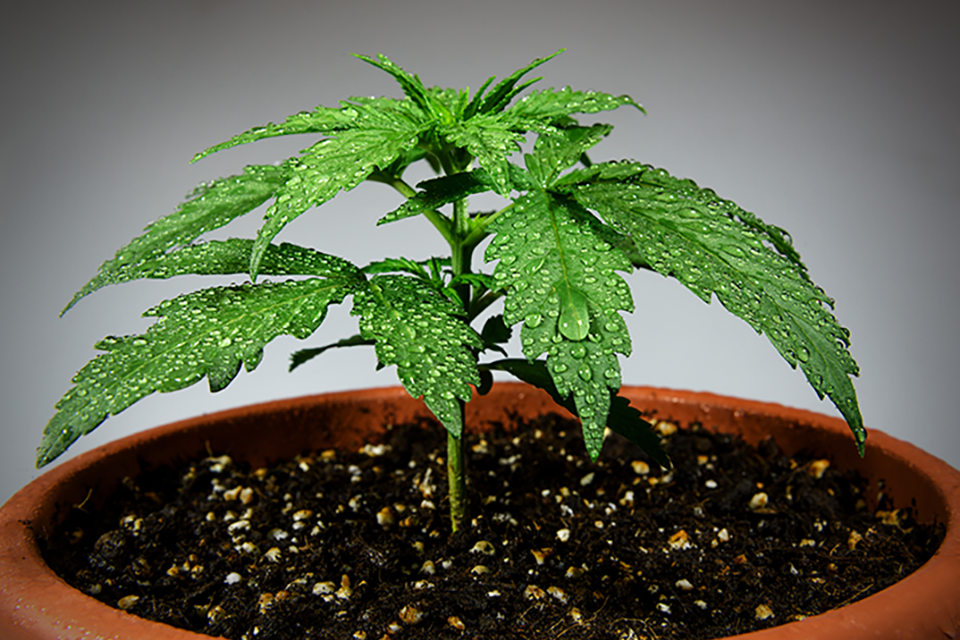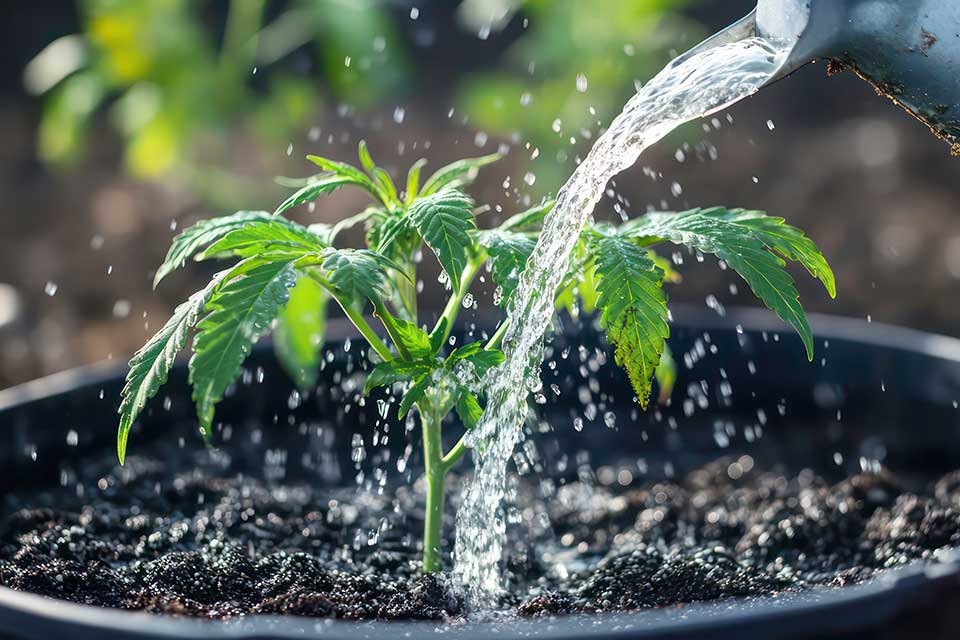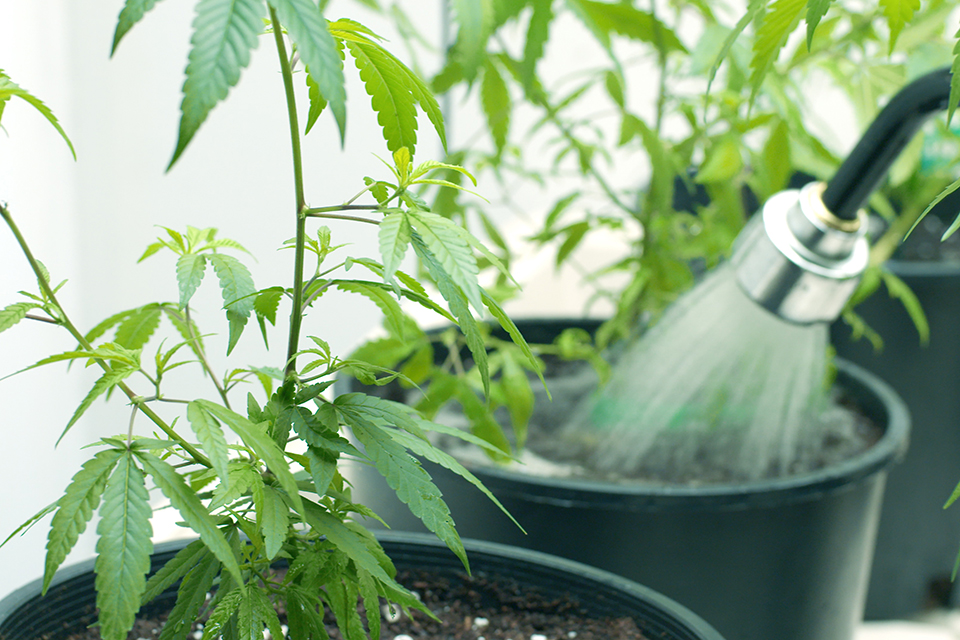
There are many integral environmental aspects that are key in supporting a cannabis plant into optimal health and maximum production. Temperature, humidity levels, nutrients, growing medium and airflow are all important in encouraging healthy growth, but water consumption is amidst the most imperative as it plays a vital role in all of the biological processes of the plant. Water facilitates photosynthesis which is the process of converting light to energy. This action is responsible for the plant creating and using sustenance at every stage of its life cycle. It assists in the development of the roots, the foliage and the buds and helps the plants in growing strong and being able to support their height, breadth and weight. Water also plays the role of carrying essential nutrients to the appropriate areas and assists the plants in regulating their temperature in high heat. In a garden plot, the water regulation will be more well managed by mother nature, but when you are growing in pots, you take this step into your own hands. There is risk of over or under watering and both of these extremes have the potential to hinder the development and bud production of your plants. In the following paragraphs, we will provide information on effectively watering your plants, managing common problems, and reviving your plants if something has gone astray. With these tips, you will be able to ensure you get the most desirable results from your efforts!
When Should I Water My Marijuana Plants?
There will be several elements of your operation that will impact the watering schedule for a weed plant. The medium, climate, strain and type of operation will all play a role and need to be considered when deciding when to water, but there are some general guidelines to work within. Plants require a balanced level of water at every stage of development, so setting up a watering schedule even before the seed germinates is necessary. Though there are no hard, fast rules considering all the various influential factors, generally during the germination stage, plants need water less frequently than through the seedling, vegetative, and flowering periods. Over or under watered soil can cause an ungerminated seed to fail, so even before the plants sprout, this element of your operation is essential. It tends to be best to water plants in the morning, as it allows them to spend the whole day absorbing nutrients and engaging photosynthesis. The heat of the day also works to evaporate extra water that could lead to fungal growth or waterlogging. This cycle of wet in the morning to nearly dry in the evening allows the roots to expand in search for water overnight. This hunt expands the system and creates a firmer base for your plants. Morning watering is great, but not usually every morning! Generally, marijuana plants only need water once every couple of days, but you can assess whether they are ready for it by checking the wetness of your soil at a few inches of depth. If it feels dry, start watering!
How Much Water Do Marijuana Plants Need?
How much water your plants need will depend on the stage they are in as well as on the other elements of your growing setup. The type of growing medium you are using plays a big part, as it will be more or less porous depending on what you choose. If you are using a medium like coco coir, it will both hold water and let the overabundance flow through, whereas a rich, silty soil might hold more moisture than is helpful for your young plants. Relative humidity levels and temperatures are other imperative elements of the grow space that will determine the amount of water needed. Humid environments require less watering and, in high temperatures, your plants will need to be replenished from what is evaporated in the heat. In the early stages, light watering is enough to sustain the plant, but as the plant matures, it needs more water. The broader surface area of the leaves allows more to move through and be evaporated from the plant, which means it needs to absorb more into its roots in order to have enough moisture to sustain the rest of its function. Although a larger plant needs more water, it does not need to be watered as frequently. The large containers required to contain a larger plant will hold more water for longer and the plants will continue to soak up the remaining water. You can slow down on watering towards the end of the flowering period, as, at this stage, they do not consume much at all.
How Do I Give My Marijuana Plants Water?
There are several ways to give your plants the water they need to flourish. It is important to consider that the quality of the water and the skilled delivery matter much more than the frequency. In fact, marijuana plants tend to only need watering two or three times per week, depending on the grow and strain. The most important thing is that they get enough, but not too much. The delivery method can make a difference especially at the various stages of growth. In the early stages, a gentle misting or spritzing will serve them best. Pouring a pitcher could drown, or damage, the delicate young plant. In the later stages, pouring water into the soil, using something like a watering can, is appropriate. Some plants would prefer not to have their leaves wet at all, so methods like bottom up watering will be imperative in their health. When you are in the later stages, remember to soak the center of the soil first. This gives the root system first dibs on the water! You also want to dispose of the runoff. If you have trays under your pots, try emptying any murky liquid as this can become a breeding ground for fungus. If you choose to grow in a hydroponic setup, rather than in soil, water is consistently delivering nutrients to the root system. A consistent flow carries the appropriate sustenance to your plants so the dry periods for root expansion are unnecessary.
What Water Should I Use For Growing Cannabis Plants?
The type of water you use to hydrate your plants can make a big difference in their health. You want to aim for reverse osmosis or filtered water for optimal results, but, many folks will simply use tap water since it is convenient and abundant. Neutral, filtered water can hydrate the plants while allowing the grower to add in appropriate nutrients throughout the grow. The issue with tap water is that it often contains a myriad of minerals, including calcium, magnesium, sodium and many others. They are present in varying quantities so, unless you test your water first, it is tricky to determine what nutrients your plants are getting, and what elements will need to be added in separately. The pH levels in your water play a part in plant health as well, and that will range depending on the geographical location and climate also. Regardless of what is naturally present in your water, remember that the quantities of specific nutrients that are required for healthy development change throughout the various stages of the life cycle. Your water might contain the optimal levels for vegetation, but flooding can cause nutrient burn throughout the flowering process. Fortunately, this can often be remedied by flushing your chosen grow medium with fresh water. The temperature of your water can impact the roots and hinder their ability to absorb nutrients too, so check that it sits at around 68 degrees Fahrenheit for the best results.
How Do I Flush My Weed Plants?
Flushing is a process that growers implement where they purge the soil of nutrients by adding in straight water. This is done to allow your plants to use whatever sustenance they have already absorbed without being flooded with excess. It can help resolve the negative effects of over feeding and will help with the diversity and strength of the aroma and flavors in your nugs. When a plant receives too many nutrients, it can stress them and create unbalanced pH levels. By continuing to wash through water with a neutral pH level, you can assist your plants in balancing out before continuing on with your watering schedule. Towards the end of the growth cycle, just before harvest, gardeners also tend to do a final flush to improve the bud quality. This flushes out any excess nutrients that have built up throughout the life cycle. You can tell the time for this final wash by the color of the trichomes. When they start turning milky, rather than clear and translucent, it is time to pour through the freshwater! The exact time frame will depend on your growing medium, with hydroponic systems being roughly five to seven days before harvest, and soil being seven to ten. A flush is not recommended if you are using nutrient dense, organic soil. These compounds are created to deliver the optimal sustenance to your plants and washing it might deplete the soil and leave your plants longing for support.
Overwatering vs Underwatering Cannabis
The most common watering issues are over and underwatering your plants. The signs of a watering problem are leaves with edges and tips that appear burnt, are curling under, are spotted or are drooping. Wilted or stunted plants with weak stems is another good indication of a hydration issue. In the root systems, you will note slow growth, a mushy texture or a bad odor. Since the roots are the foundation of your plant, this must be addressed as soon as possible! Overwatering will leave the roots susceptible to rot and waterlogging, both of which will prevent the plants from absorbing adequate nutrients to propel their growth. This excessive water could also lead to bacterial and fungal growth which can cause a plethora of unpleasant diseases. It is harder to correct flooding your plants than underwatering, and some, unfortunately, will never fully recover. However, underwatering can pose serious issue as well. It can lead to your plant being dehydrated. The roots will dry out and be unable to fulfill their purpose and leaves will discolor and fall from the branches. Depending where the plant is in its life cycle, it is easier to miswater. For instance, in the seedling stage, the plant will thrive with a gentle spritzing with a spray bottle, rather than a heavier watering which will well support the vegetation stage. Later in their journey, they are generally hardier and can hold their own in the face of slight water shortages and abundances.
How Do I Water My Plants If I Am Away?
Watering is an essential part of caring for your plants so, even when you are adventuring around the world or taking a week to lounge on the beach, you have to make sure they are staying hydrated. There are several methods you can use that will assist you in maintaining your watering schedule, even while you are far from home. There are also several DIY solutions that are effective and inexpensive. Try drilling a hole in a bottle cap, placing it back on the container and hanging it cap side down over your plants. This will create a slow drip that will keep the relative humidity at the appropriate levels. You could also take a clear plastic bag and hang it from a bamboo pole over top of a pot to form condensation. Both of these methods are cheap or free and will slowly deliver moisture to your home grow operation. You could also invest in an irrigation system. These timer-controlled systems are going to be a bit more expensive, but are a superb solution to effective watering from abroad. Another tool that can be purchased is a smart drip setup. This is essentially the same as the water drip, except it is also on a timer so you can maintain a regular schedule of watering at the optimal times to encourage plant health. As has been discussed, watering at specific times of day aids in healthy development, so water systems on timers are preferred for attaining optimal results.
Can I Revive My Underwatered Cannabis Plants?
Bouncing back from underwatering your plants is much more simple and effective than managing the impacts of overwatering, however, that does not mean that no significant damage was done. Underwatering still debilitates the plants biological processes and effects their ability to absorb water and nutrients. The stomata, little openings on the leaves which regulate the plants heat and moisture content, will close to preserve what little water they have. This blocks the plant from attaining other necessary elements for photosynthesis and will limit their nutrient uptake and growing energy. The result is weak, withering plants with browning or falling leaves. As soon as you notice these signs, it is important to start correcting your watering methods. Early detection will hopefully curb long term effects. The effects of overwatering and underwatering look similar, so adding a bit of water to the plants soil and seeing a wilted plant revive will be a good indication that a lack of hydration is the issue to address. Fortunately, all you need to do when your plants are dehydrated is add more water. You will want to offer them a pH balanced, clean water so they can drink without also needing to do the work of processing other nutrients. Give them a little time just to pick themselves up and start functioning properly and growing rapidly, and then make any necessary nutritional adjustments once your plants are strong enough to absorb them and effectively put them to use.
Can I Water From The Bottom?
When you think of watering your plants, you likely envision yourself pouring water onto the surface of your potting soil. While traditionally this is the method of delivery, when you are growing in pots, there is also the option to water from the bottom. This is the preferred method for certain plants, like those that experience health issues, like discoloration, when water is dropped onto their leaves. Sometimes a pot becomes root bound and water will not effortlessly absorb into the soil. This is another time that bottom watering may be the more effective delivery method to retain adequate moisture levels in your plants. This method also has the potential to develop a more robust root system in any plant, as the roots are always growing in the direction of the water. Determining when to water is comparable to top watering, simply stick your finger into the soil down to the second knuckle and if it does not feel moist, it is time to water! All you need to do is fill a container with water and let your plant sit in it until it seems to have absorbed all it can. Plan to stay close by for about 20 minutes while your soil absorbs the water it needs and then, remove the excess water and repeat the process as necessary! The only problem is that bottom watering does not rinse your growing medium. So, in order to wash away deposits and excess nutrients, pour clean water through the top about once per month.


